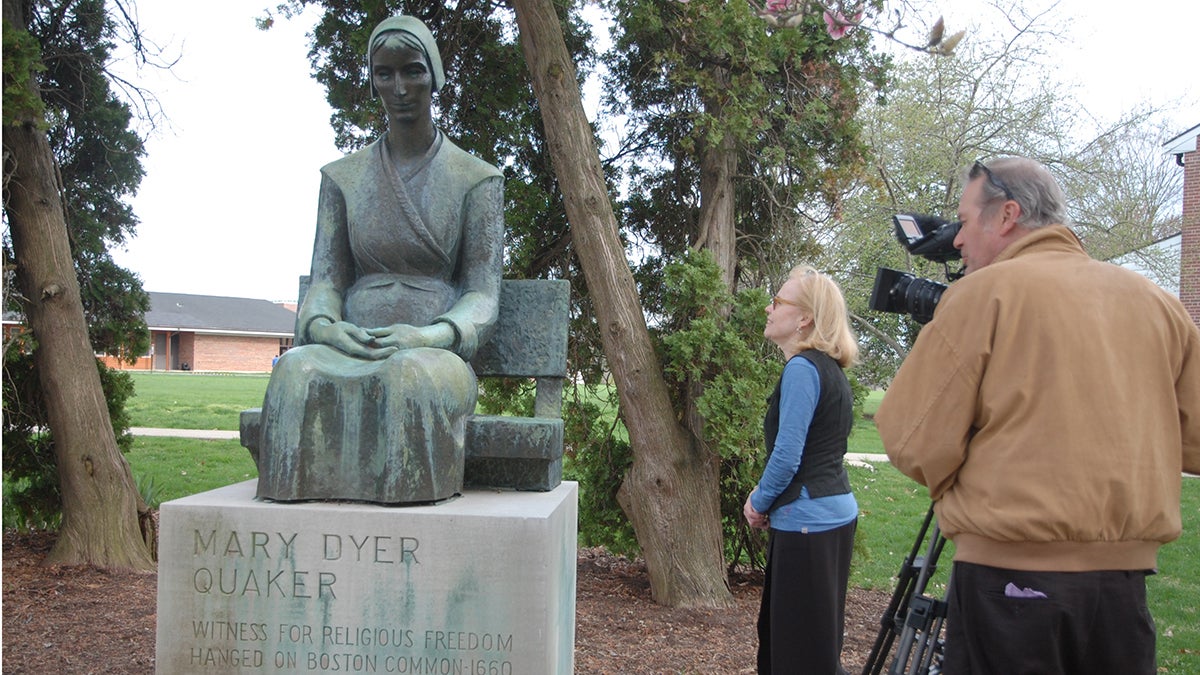Documentary makes noise about quiet revolutionaries

The cylindrical box of oatmeal with the white-haired man in the tall black hat is as iconic as an American image gets. As a result, many associate the Society of Friends with the Quaker Oat Company, imagining people clad in old-fashioned garb riding buggies.
Because Quakers convey quality and reliability, their image has been used to market everything from safety matches and whiskey to cigars and even a 19th-century chamber pot – yet many of these are products Quakers wouldn’t even approve of. In the early 20th century there was an unsuccessful effort to get a bill through Congress that would have prevented using religious organizations to promote products but the Quaker Oats lobby blocked it, according to Thomas Hamm, a professor at Earlham College, interviewed in Quakers: The Quiet Revolutionaries, a documentary in the making by the Gardner Group. “It is often said that Quakers have an influence beyond their numbers,” says Ben Pink Dandelion, a Quaker scholar affiliated with the University of Birmingham, England, also interviewed in the film. In New Jersey and Pennsylvania, we are surrounded by remnants of Quaker culture, from schools (Haverford college among them) to Philadelphia’s historic Bartram Garden, founded by Quakers. Sixty-one versions of “Peaceable Kingdom,” painted by Quaker Edward Hicks, hang in area museums from Philadelphia to Newark. We have Quaker prisons in our midst – Eastern State Penitentiary in Philadelphia was influenced by Quaker thinking, where inmates, in solitary confinement, could be penitent in cells with skylights. The Society of Friends – the preferred name for Quakers – was among the first group of Europeans to settle along the Stony Brook in Princeton, establishing the stone meeting house that is still in operation today. Built in 1726 and rebuilt in 1760, it is the oldest house of worship in Princeton. Within its walls, worshippers sit in silence, meditating, a silent form of prayer. When a worshipper feels moved, he or she may speak to share a thought or observation, announce a humane cause, or even sing a song. A fundamental principal of Quakerism is “the light within,” which many Friends interpret as a direct and unmediated experience of the divine that guides everyday lives and brings together a community of people. Meeting for Worship is considered an opportunity for deep personal growth and spiritual nurturing.Award-winning filmmaker Janet Gardner, who lives in Rocky Hill and New York City, observed films about Muslims, Amish and Jewish culture being screened on PBS, but saw little about Quakers. “Even the series ‘God in America’ only had a passing nod to Quakers,” she says. “I became passionate about the English part of the story.” Last year Gardner, who initially funded the project with a kickstarter campaign, received a Guggenheim Fellowship. “This will significantly enable us to proceed with the principal photography and attract more support,” she says of the film, which is halfway complete.Among the reasons Quaker history may be underrepresented, postulates Gardner, is because Quakers don’t proselytize. Also, their propensity to be thoughtful decision makers — they believe in achieving consensus before moving ahead – may have deterred some film projects. Quakers are often mistaken for Amish and Mennonites, and with Shakers – an offshoot of Quakers with whom they share a physical trembling of the body during worship.Gardner and her late husband George Morren, an anthropologist, Rutgers professor and Rocky Hill mayor, joined a pilgrimage in 2010 from Philadelphia to England where George Fox was said to have had his vision. In the mid-17th century, Fox, who was tall and charismatic with a powerful voice, shared his belief in an “inward light” and that there is “God” (Quakers believe in the Christian god) in all of us. After not eating for days, he said he felt moved to go to the top of a hill. His vision, considered the beginning of Quakerism, was that anyone could have a direct relationship to “God,” everyone is a minister.In 1662, the Church of England passed an act that made Quakerism illegal, and 11,000 were imprisoned, says Dandelion. Four hundred died in prison. Quaker women’s heads were covered with a bridle and a metal piece that cut their tongues – trembling and shaking were considered dangerous hysteria. Fox worked with Margaret Fell, who was married to a pre-eminent judge, to promote the idea that women were responsible for bringing the community to meeting, or worship. Fell and her husband took in Quakers and protected them. For this, Fell’s land was taken away and she was sentenced to time in Lancaster Prison, where Fox was also imprisoned. When her husband died, Fell married Fox.The original name was the Religious Society of Friends of the Truth. When Fox was in court, the judge, mocking Fox for being charismatic, asked, “Do you shake before the Lord?” and Fox replied “Yes, and you should as well,” according to a rough cut of the film.“They didn’t like the name Quakers, but resigned to it and that’s how they’re now known,” says Gardner.The former field producer, film editor and news writer for NBC News and WNBC-TV, WRC-TV (Washington, D.C.) and CBS News views herself as a “participant observer.” Gardner says she came to Quakerism slowly. Raised an Episcopalian, she met Quakers, who protest all wars, while she was reporting on Agent Orange for the Cleveland Plain Dealer, The New York Times, Philadelphia Inquirer and Boston Globe, and making films about the Vietnam War and Cambodian atrocities: Dancing Through Death (1999), about the Cambodian monkey dancers, and the Emmy-nominated A World Beneath the War (1997). Quakers, early civil rights activists and followers of Gandhi’s civil disobedience, were among the first conscientious objectors.Quiet Revolutionaries has been brewing inside Gardner for a number of years. “I always knew I’d make this film,” she says. “From a budgetary and length standpoint, it’s my most ambitious film.”
_________________________________________________________
The Artful Blogger is written by Ilene Dube and offers a look inside the art world of the greater Princeton area. Ilene Dube is an award-winning arts writer and editor, as well as an artist, curator and activist for the arts.
WHYY is your source for fact-based, in-depth journalism and information. As a nonprofit organization, we rely on financial support from readers like you. Please give today.





